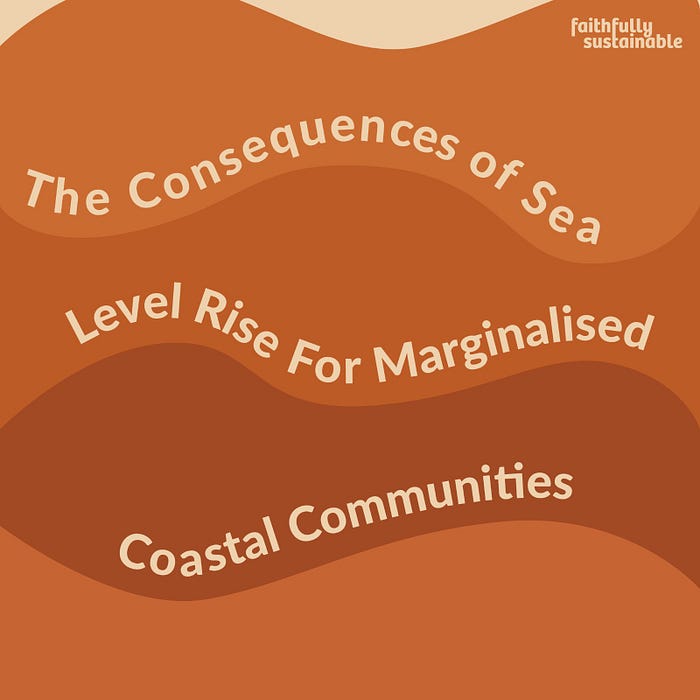
The Consequences of Sea Level Rise for Marginalised Coastal Communities
By: Nausheen Mazari
Editors + Contributors: Kadiatou Balde, Memona Hossain and Hadeel Abbas
“Corruption has appeared on land and sea because of that which men’s hands have done” (Quran. 30: 41)
The Science Behind the Current Climate Crisis
Global warming continues to threaten humanity and the biodiversity of Earth. Scientists and climate experts agree that global warming at the current record-high rate is directly caused by human activity. Industrialisation by the Global North has destroyed the natural state of the atmosphere, ocean, cryosphere and biosphere.
The Cryosphere consists of locations where water is frozen in a solid form. Some include sea ice, glaciers, icebergs, and ice sheets.
The Biosphere is a global ecosystem formed by the interactions between living organisms (scientifically referred to as biotic factors, such as plants, animals and bacteria) and non-living components (abiotic factors, such as the atmosphere, temperature and sunlight).
The Atmosphere is the mass of greenhouse gasses surrounding a planet. Naturally occurring greenhouse gases play a crucial role in warming the planet to create ideal conditions for all life on Earth.
The complexity of various processes contributing to sea level rise are naturally difficult to observe and quantify. Scientific evidence illustrates how global warming is directly linked to faster and higher rates of sea level rise. This is described below through three main, intertwined factors linked to sea level rise:
Thermal expansion
This refers to when water heats up, naturally its volume expands. As a result, warmer water simply covers more surface area. This occurs when the concentration of greenhouse gases is high, as oceans mitigate the effect in the atmosphere via absorbing the heat. It is estimated that more than 90% of heat is absorbed by oceans, and half of sea level rise in the last 25 years is linked to this phenomenon.
Melting glaciers
Naturally, large ice formations melt in summer, then snow from evaporated seawater mitigates any loss. In recent years, global warming has disrupted this seasonal balance as late winters and early springs are becoming normal. Consistently higher temperatures leads to substantial summer melting in the cryosphere, and less snowfall to replace melting.
Loss of Greenland and Antarctic Ice Sheets
Destabilising of ice sheets in West Antarctica have already been observed by scientists, whilst glaciers in East Antarctica are appearing to destabilise. When large amounts of meltwater are observed above, which seeps beneath ice sheets, this easily lubricates ice streams. Consequently, this meltwater interaction moves ice streams rapidly into the sea.

Communities with the Smallest Environmental Footprint are Most Impacted
The world population is concentrated along the coast, where cities are increasingly urbanised. Climate science models designed to project the future of coastal cities illustrate dangerous changes to these cities. Storm surges, hurricanes, typhoons, and floods are projected to occur more frequently. At the current rate of global warming, it is almost certain coastlines will decrease drastically.
“We define dangerous climate change effects as those that are irreversible, spiralling (self-reinforcing), very large or very rapid, and with a serious impact on natural and human systems”
- Met Office, The Science Behind Climate Change
More alarmingly, this is not a hypothetical or modelled prediction for marginalised coastal communities. They live sustainably off natural resources and have small environmental footprints. For example, according to a Greenpeace Australia Pacific report, the Pacific region emits only 0.23% of global emissions making it one of the smallest carbon-emitting regions globally. Yet, communities in the Pacific are confronted with severe effects of rising sea levels and global temperature, ahead of projections for coastal cities around the world.
“Catastrophic floods and storms have been occurring with considerable frequency: once in 50-to-100 year events have been happening every 10 years. Immediately one can conjecture that catastrophic cyclones, super cyclones, prolonged drought, will become much more frequent and much more intense across the Pacific small islands.”
-Dr. Satyendra Prasad, Pacific small states representative to the UN
Case Study: The Disappearing Solomon Islands as a result of Climate Change
The Solomon Islands is located roughly 1, 000 miles north-east of Australia in the South Pacific. It is a collection of small pristine islands, with a population of approximately 686, 878 in 2020.

Global mean sea level rises by 0.13 inches yearly due to human activity. Mean sea level refers to the average surface level of bodies of water. This number is used to quantify and measure elevation. The average rate of sea level rise in the Solomon Islands is remarkably higher than the world average, where at least 5 low-lying islands had completely disappeared into the ocean by 2014.
Additionally, 6 other islands have decreased by 50% in size. On two of these reduced islands, whole villages were destroyed, which left communities with no choice but to migrate. On other threatened islands, younger generations are choosing to relocate due to compromised safety.
Environmental disasters are another unintended consequence of sea level rise. In 2020, Cyclone Harold ravaged an extensive area of villages in the Solomon Islands, as well as Fiji, Vanuatu and Tonga. Such environmental disasters are already heightening in frequency and intensity as global warming continues, further reducing habitable areas.
Many elders do not want to relocate and have expressed fear that they may lose their traditions, culture and way of life. Leader of the Paurata tribe, Sirilo Sutaroti aged 94, among others was forced to leave behind his village and relocate to higher ground. Similarly, families in Nuatambu have migrated to the larger island of Choiseul. Once a whole village, Choiseul is now fragmented into 5 individual communities, which is detrimental for their intergenerational kinship ties. Individuals in these communities face cultural, spiritual, and psychological disruption through involuntarily uprooting their lives.
The climate crisis endangers the livelihood and culture of Pacific islanders as they are facing the brunt of sea level rise ahead of future projections for the world. Many have lost hope for the future of their home. These communities are in dire need of immediate action for climate justice.
Projected global warming trends indicate future extreme water stress in the Pacific
Water stress, also known as water scarcity, occurs when the demand for freshwater resources exceeds supply. This can be categorised as physical water stress, where there are environmental limitations to how much water is available. Contrastingly, economic water stress results from poor infrastructure and management of water resources.
In 2016, an international target was set in the Paris Agreement to halve greenhouse gas emissions by 50%. The agreement required all parties to limit heating that surpasses 1.5°C above pre-industrial levels. This ambitious target was possible through sustained lobbying and effective leadership by the Pacific Islands. However, major countries adding to global greenhouse gas emissions have failed to uphold their commitment to the Paris Agreement target.
The 2021 IPCC (Intergovernmental Panel on Climate Change) landmark report published earlier in 2021 highlighted insufficient climate action from the Global North, and consequently catastrophic scenarios for all Pacific Islands. The report estimated at the current rate of global warming, we will reach 1.5°C between 2030–2052. Every inch of sea level rise in the Pacific entails cascading dangerous impacts.
Controlling warming at approximately 1.1–1.5°C can prevent substantial risks for the environmental health of Pacific Islands. Coastal resources, such as fisheries and aquaculture are predominant drivers of their economic growth. Living harmoniously with the coast is ingrained in the culture of Pacific Islanders. Depleting coastal resources will impact cultural identity, and cause loss of deep knowledge systems and economic stability.
The projected temperature increase of 1.5–2°C entails higher frequency and intensity of extreme weather. This scenario could make entire islands inhabitable, contributing to the fluctuation of climate change refugees. Leaders from the Pacific Islands believe the timeline for such large-scale catastrophe will draw closer if the Global North does not act on the climate crisis immediately.
How Pacific Islanders Are Adapting to the Climate Crisis
Western conservation strategies are heavily reliant on technology, which is not economically viable for marginalised and vulnerable communities. In the Pacific, including on the Solomon Islands, nature-based solutions and ecosystem adaptation are effectively implemented.

Nature-based solutions refers to focusing on either maintaining or improving the naturally existing functions of an ecosystem. This environmental solution preserves long-term health and resiliency, as it allows the environment to naturally respond and maintain against climate change disturbances.
Building sea walls is not financially attainable on Choiseul, where sea level rise and coastal erosion threaten the island. Instead, protection is achieved through conserving coastal rainforests. This works by developing opportunities for Indigenous landowners to create and sell rainforest carbon offsets, increasing measurable value of natural resources. In doing so, there is a larger incentive to conserve natural ecosystems.
Elders of the Solomon Islands and the Pacific as a whole lead their communities with a wealth of generational knowledge about their ancestral land. Indigenous and traditional knowledge is becoming more integrated into nature-based solutions. Conservationists are recognising the valuable potential for Indigenous and traditional knowledge to guide climate adaptation strategies globally.
Despite painting a grim future the accelerating climate crisis has proved the strength, leadership, and solidarity within Pacific Islander communities. Their continual adaptation and resilience when faced with adversity leaves one clear message; that there is still hope for their future.
“Our reality has been used to highlight the climate crisis for decades… The conversation is shifting, everybody is now understanding the reality of the climate crisis, that’s why it’s important to centre frontline communities more than ever”
-Joseph Sikulu (Pacific Regional Managing Director for 350.org)
Note: We are a group of BIPOC Muslims interested in the intersections between environmental justice and Islam. We are by no means Islamic scholars or academics and the information provided in this article came from the following sources.
Sources
- Climate Change 2021: The Physical Science Basis https://www.ipcc.ch/report/ar6/wg1/downloads/report/IPCC_AR6_WGI_SPM_final.pdf
- Sea Level Rise and Implications for Low Lying Islands, Coasts and Communities https://www.ipcc.ch/srocc/chapter/chapter-4-sea-level-rise-and-implications-for-low-lying-islands-coasts-and-communities/
- Sea Level Rise, Explained https://www.nationalgeographic.com/environment/article/sea-level-rise-1.
- Five Pacific Islands Lost to Rising Seas as Climate Change Hits https://www.theguardian.com/environment/2016/may/10/five-pacific-islands-lost-rising-seas-climate-change
- IPCC Report Shows “possible loss of entire countries within the century” https://www.theguardian.com/world/2021/aug/10/ipcc-report-shows-possible-loss-of-entire-countries-within-the-century
- Te Mana O Te Moana: The State of the Climate in the Pacific 2021 https://f.hubspotusercontent30.net/hubfs/8586633/Te_Mana_o_te_Moana-The_state_of_the_Climate_in_the_Pacific_Report_2021.pdf?hsCtaTracking=02277be6-c1a3-462d-81cb-aed83d452f53%7Cf0e8a15b-a38b-4e05-a325-51691429f0e2
- The Vanishing Island https://www.smh.com.au/interactive/2015/the-vanishing-island/
- The Science Behind Climate Change https://www.metoffice.gov.uk/weather/climate/science/the-science-behind-climate-change
- Pacific islanders work with nature to combat climate change https://www.gcca.eu/stories/pacific-islanders-work-nature-combat-climate-change
- The Role of Indigenous and Traditional Knowledge in Ecosystem-Based Adaptation: A Review of the Literature and Case Studies From the Pacific Islands https://journals.ametsoc.org/view/journals/wcas/10/4/wcas-d-18-0032_1.xml#s3
- Uneasy Waters: http://www.uq.edu.au/research/impact/stories/uneasy-waters/
- Rising sea levels: A tale of two cities: http://news.bbc.co.uk/2/hi/science/nature/8369236.stm






